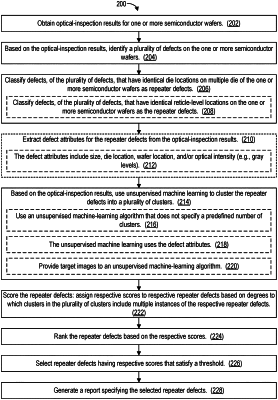| CPC G06T 7/0004 (2013.01) [G06F 18/23 (2023.01); G06F 18/24 (2023.01); G06N 5/04 (2013.01); G06N 20/00 (2019.01); G06T 7/70 (2017.01); G06T 2207/30148 (2013.01)] | 27 Claims |

|
1. A method, comprising:
obtaining optical-inspection results for one or more semiconductor wafers;
based on the optical-inspection results, identifying a plurality of defects on the one or more semiconductor wafers;
classifying defects, of the plurality of defects, that have identical die locations on multiple die of the one or more semiconductor wafers as repeater defects;
based on the optical-inspection results, using unsupervised machine learning to cluster the repeater defects into a plurality of clusters;
scoring the repeater defects, comprising assigning respective scores to respective repeater defects based on degrees to which clusters in the plurality of clusters include multiple instances of the respective repeater defects; and
ranking the repeater defects based on the respective scores.
|